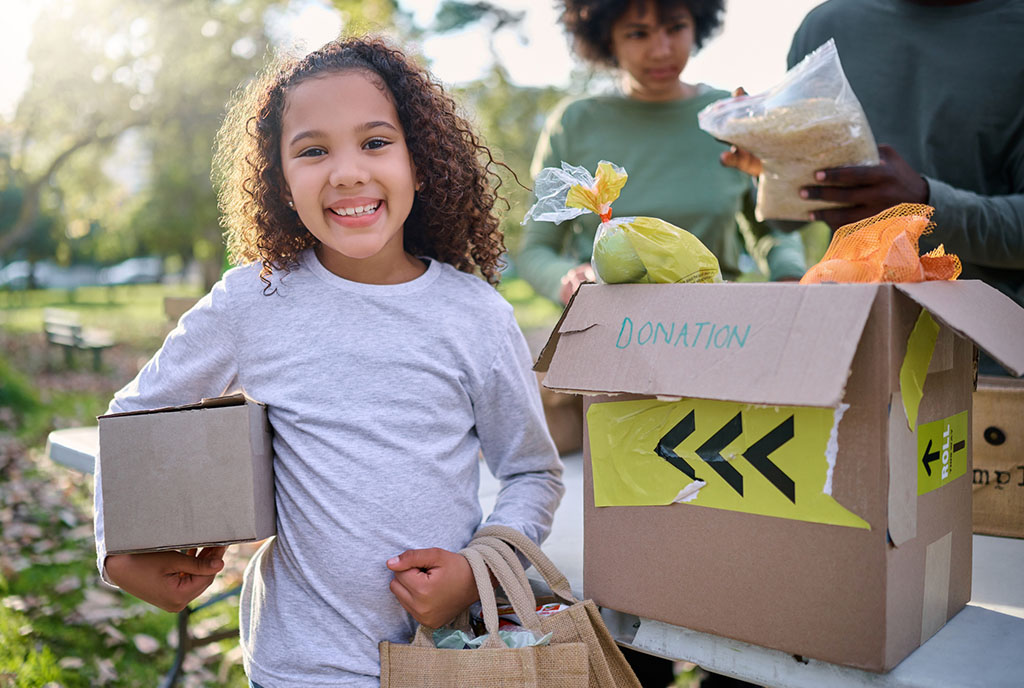
When Amy Neugebauer’s third-grader son came home from school one day, he ran upstairs to raid his piggy bank for an American Heart Association fundraiser. Neugebauer wondered why he was so excited. The response was telling: “You get the free T-shirt.”
Many school-based giving initiatives, it turned out, were linked to rewards. For older kids, a minimum number of “service learning hours”—through volunteering, for example—is required to graduate from many high schools. This reliance on external drivers did not sit comfortably with Neugebauer, whose background is in community development and social innovation.
“Bringing in money and resources to organizations is a really important thing to do, but we miss this opportunity to build a foundation of civic and community engagement,” she told NPQ.
Neugebauer founded The Giving Square in 2018 to try to fill that gap. “My intention was never to start a nonprofit. But it became this string that I started pulling, and I became kind of obsessed with this missed opportunity,” she said.
“Philanthropy at schools happens without us talking about it.”
Shifting from Pity to Solidarity
Children are often encouraged to contribute by evoking pity, said Neugebauer (the classic example: “Eat up your peas—there are starving kids in Africa.”). A healthier message, according to Neugebauer, would be that we help because we can, and because we, too, might need help someday. “So,” she wondered, “how do we break out of this pity?”
Dr. Alison Body, head of impact and research at the UK environmental charity Global Action Plan, and until recently a lecturer in philanthropic studies at the University of Kent, also urges a shift toward solidarity—and much greater recognition of children’s agency.
Her research—including a recent book, Children as Change Makers: Unleashing Children’s Real Philanthropic Power—shows that young people are typically seen in one of two ways within philanthropy: as passive recipients or as future inheritors of wealth. While children are increasingly involved in school-based fundraising, this is often framed as the “haves” giving to the “have-nots.” Pupils get little or no say in who or what they will fundraise for. Afterward, most of them can’t recall what cause they were supporting.
“Philanthropy at schools happens without us talking about it. Every single child is involved in donating in some way,” Body said.
In the UK, this is often for large national charities such as Children in Need, which raised £3.5 ($3.79) million from schools from 2023 to 2025. In the United States, the American Heart Association’s Kids Heart Challenge, which also provides resources to support students’ wellbeing, is popular. Multiple schools have reportedly raised $10,000 to $30,000 in a year for this cause; from 2023 to 2024, Kids Heart Challenge and the related American Heart Challenge raised a total of $67 million from 16,000 schools.
“We want kids to see that giving is hard work….You get better the more you do it.”
But, when fundraising happens without much critical discussion alongside—for example, about why nonprofits exist or what systemic failures have caused the problems in the first place—we send the message that donating money will solve all social ills.
Children are vastly more capable of critical thought than we give them credit for, Body added. Even at the age of four, storytelling and play can introduce concepts of kindness, fairness, and helping others. Children of all ages can connect to the idea of the “philanthropic toolbox,” whereby giving money is just one tool, alongside giving time or advocacy, for example.
“Research tells us again and again: Middle childhood is absolutely vital for developing our civic, social, and political orientations and those wider views on the world,” Body added.
This is also the ethos at The Giving Square. Working with children aged 7 to 13 in around 50 schools in Maryland, Virginia, and Missouri, Giving Square programs cover self-awareness, empathy, and experiential learning. The nonprofit also supports students to host a podcast and review books for an annual award celebrating stories that build empathy and responsibility to others.
The Giving Square defines philanthropy broadly—“giving of yourself for the good of humanity”—but it insists on using “philanthropy” rather than more everyday words like compassion or generosity.
“There’s an art and science to giving, so it needs a hard word. We want kids to see that giving is hard work, and it’s similar to reading or math or soccer: You get better the more you do it,” Neugebauer said.
The Giving Square allows kids to experience that hard work: Programs for third-to-fifth graders support students in evaluating various local youth-focused nonprofits and ultimately deciding where to allocate $1,000. Last year, students distributed $48,000 through The Giving Square. Just as importantly, children see themselves as philanthropists by the end, Neugebauer said: “They’re more inclined to want to help others. They have more tools to help others.”
Learning Compassion
More than 80 percent of K–12 schools in the United States now use social and emotional learning (SEL) curricula, which cover competencies like self-awareness and healthy relationships, and promote prosocial behavior.
“I can see how good social and emotional learning could really promote philanthropy long term,” said Tish Jennings, a professor of education at the University of Virginia. An SEL curriculum cocreated by Jennings emphasizes compassion and local action, for example. “It’s about looking at the big community that you feel part of, and wanting to do something to make it better,” she said.
Sign up for our free newsletters
Subscribe to NPQ's newsletters to have our top stories delivered directly to your inbox.
By signing up, you agree to our privacy policy and terms of use, and to receive messages from NPQ and our partners.
Ascertaining the breadth and quality of philanthropy education is difficult, partly due to terminology. The Giving Square identified more than 120 similar organizations across the United States engaged in philanthropic education in the broadest sense—but very few use that term, noted Neugebauer, instead categorizing their work as youth development, civic education, advocacy, and so on.
Education provision also varies between states and districts. Even with a standardized curriculum, SEL delivery would vary depending on the teachers and students involved, noted Teri LeSage, a senior consultant and educator at Wipfli, an advisory firm.
“Anytime you’re working with people,” LeSage said, “it’s going to be messy.”
Democratizing Philanthropy
Body raises concerns that philanthropic and broader citizenship education isn’t as accessible to those of less privileged backgrounds.
In England, as in the United States, many teachers who work in schools serving lower-income students are responding to a raft of challenges beyond their official job, such as providing food, brushing teeth, and even helping parents with budgeting. In such cases, there is understandably less space to focus on social action or critical debate. Where their own pupils are directly affected by racism or poverty, teachers might feel it’s safer to avoid discussing them, said Body. Her worry is that while the more privileged enter adulthood feeling confident and articulate in speaking out—and expecting to be taken seriously—those from less privileged backgrounds “are quite often dismissed as the victim.”
Neugebauer shares similar concerns around equity. When she started The Giving Square, most people assumed it would partner with wealthy schools. In fact, over 60 percent of programs are offered in lower-income communities.
“Many community schools have said, ‘The reason your program is compelling is that our children are often seen as the recipients, and this is the first time they really see themselves as contributors to the community,’” said Neugebauer.
The programs run by UK charity First Give are another good example, according to Body. Pupils aged 11 and up research issues affecting their local community, identify and speak to a charity addressing their selected issue, and create a social action (such as fundraising or awareness raising) on its behalf. Finally, they present their work to an audience, and judges select a winning group to receive a grant of £1,000 ($1,263) for their charity.
Children are natural philanthropists…[with] “a very clear sense of right and wrong.”
Among the almost 200 secondary schools in England and Wales participating last year was East London’s Sydney Russell School, where an above-average portion of students are eligible for free school meals. The school is involved in many initiatives, often supporting larger charities, but students’ engagement with those is limited, said Associate Assistant Vice Principal Charlotte Morton.
First Give is different because students choose the cause, and they have to understand the charity’s work. “It gives them an awareness of what’s happening in their local area, and makes them see they can make a difference,” Morton said. “It doesn’t have to be contributing by giving money. They can give up their time, and they can share knowledge [or] raise awareness.”
Boldly Reach Out
Short of overhauling our education system, how can adults nurture the philanthropic citizens of the future?
School leaders should try to involve nonprofits in their work: This improves the quality of education and can provide experiential learning and interaction with people who have directly experienced the issues, according to Body. And schools that work with nonprofits are three times more likely to approach an issue through a social justice lens, she said.
Nonprofits, meanwhile, should “boldly reach out to educators,” advised LeSage, as school staff are likely to share their long-term goals but may be stretched too thin to take the first step.
Parents can help, Neugebauer suggested, by giving children space to reflect on their strengths and challenges, encouraging empathy through conversations and stories, and praising them for small, everyday actions like helping a neighbor.
Perhaps the most impactful thing adults can do is get out of the way. Children are natural philanthropists, Neugebauer said: They are empathetic, open-minded, and have “a very clear sense of right and wrong.”
What’s more, Neugebauer noted, they’re well suited to challenging conventional approaches to philanthropy. “They’re not bound by the limitations of ‘That’s not how we do it.’”
Anna Patton is a student of philanthropy at the University of Kent, where she was a student of Alison Body’s module last year. Body taught at the University of Kent until recently.








